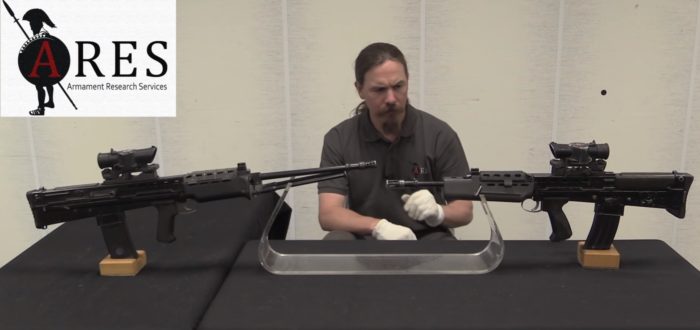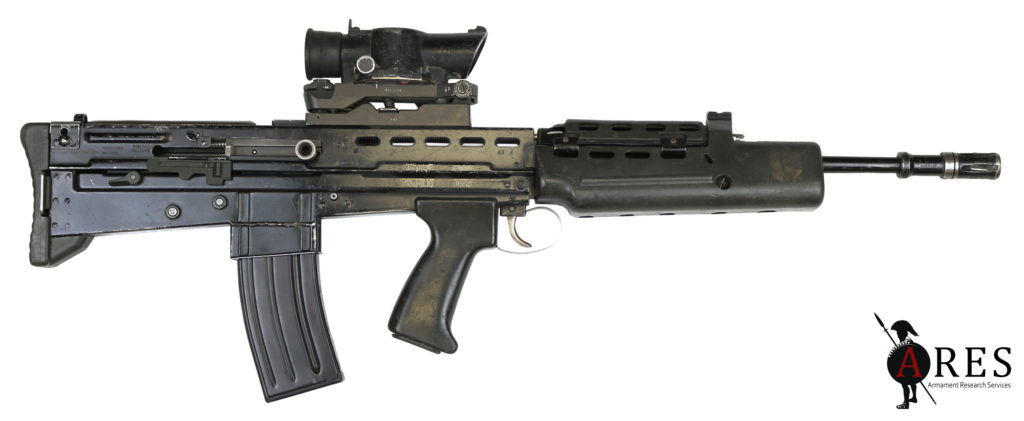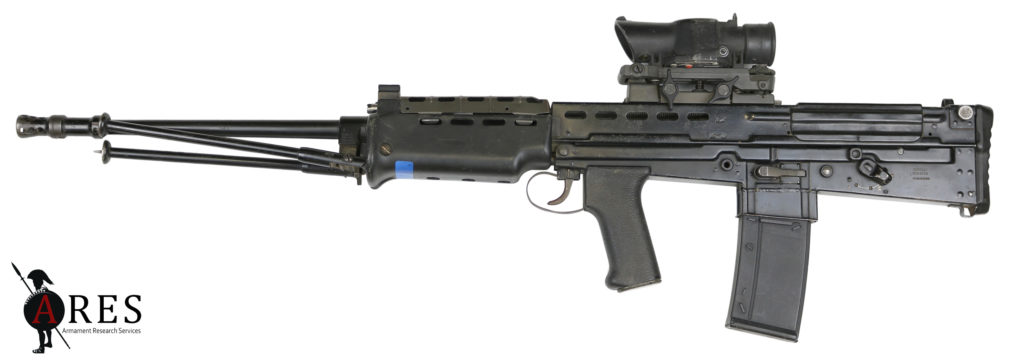Note: The information in this article has been superseded by that published in Jonathan Ferguson’s important original research work, Thorneycroft to SA80: British Bullpup Firearms, 1901–2020. That book is available from the Headstamp Publishing website: https://www.headstamppublishing.com/bullpup-rifle-book
This post accompanies the sixth in a series of collaborative videos produced with ARES Researcher Ian McCollum, who also runs the Forgotten Weapons blog and YouTube channel. Using access to unique collections facilitated by ARES, this series of videos will examine a range of interesting weapons over the coming months. Each video will be accompanied by a blog post, here on The Hoplite, and supported by high quality reference photographs. – Ed.
Jonathan Ferguson
As our first and second instalments in this series show, there were already significant issues with the first few iterations of the new prototype ‘Small Arms of the 1980s’ (SA80) family of weapons. From an initial concept in 1971, these had seen eight years of development by the time they emerged from NATO ammunition trials in 1979. At this time, the initial emphasis on building these weapons in a new British calibre, the 4.85 x 49 mm cartridge, shifted and the 5.56 x 45 mm chambering came to be accepted. The internal project name became ‘Enfield Weapon System’, rather than the earlier ‘485 Weapon System’, in a tacit recognition that 4.85 mm was effectively dead. The calibre was not the only casualty however, as the weapon itself was about to be radically redesigned. RSAF Enfield lacked experience in the design and especially the manufacture of contemporary firearms, and the definitive XL64E5 IW (rifle) and XL65E4 LSW (LMG) had shown serious problems with functioning and excessive barrel wear. They had been expected to achieve a mean rounds between failure (MRBF) rate of 2500 MRBF for the IW, and 8000 for the LSW. The early figure after the NATO trial was exceptionally low, at just 97 – indicating weapons unfit for military service.
The issues which resulted in this poor performance could no doubt have been resolved; these were after all prototype designs that had yet to pass through Ordnance Board, ‘user’, and troop trials. The coincidence of the NATO ammunition trials was unfortunate timing in that it interrupted development, but at the same time it was an opportunity to spot serious issues early on and rectify them before formal British trials began. The design was promising enough, and the need for a new British rifle and machine gun urgent enough, that it was decided to move ahead with the next developmental iteration. Unfortunately, before any individual issues with the original design could be tackled, the cost of production was deemed to be too high and a second round of ‘value engineering’ (VE) was demanded. This was supposed to be a refining of an already proven and functional design to make it more economical to produce. The first VE study had changed minor details like the shape of controls or individual contours of the receiver. Yet only four years after the original weapon system had been launched, the findings of this new study resulted in a substantial and visually obvious redesign; practically a new gun (the subject of this piece and accompanying video). This ‘reset button’ approach only compounded the factory’s existing difficulties, with the original targeted in-service date (ISD) of 1983 just a few years away.
Embodying the value engineering feedback, another short run of prototypes was produced, this time just three rifles with serials prefixed ‘PR’ for ‘Production Rifle’. The new design was much bulkier and more wedge-shaped compared to the svelte XL60 (superficially it is very close to the final SA80 design). As a result, weight increased; unfortunately, due to the VE focus on cost-saving, quality did not. In fact, with limited experience of pressing and welding, and morale increasingly an issue, quality control was variable from this point until the closure of the Enfield factory in 1988.
Nonetheless, the design itself had issues beyond this. The new pressings were thin and easily distorted, despite the new rifle weighing a full kilogram more than the XL64E5. The new trigger mechanism housing (TMH) was also found to be insufficiently strong to support a loaded magazine. The TMH magazine well was a short, lipped design just a few millimetres tall. The trigger mechanism was also substantially redesigned, and the safety reverted to a cross-bolt type, in an effort to minimise inadvertent operation by left-handed users. This allegedly became critical much later on when the final L85A1 was in service, as the polymer catch – chosen on cost-saving grounds – swelled with environmental changes and became difficult to operate. The SUSAT, still in prototype stage, was given a new mount, operated by a single throw lever. For now, these guns carried over the existing mechanical design of the XL60 series, with the exception of a new bolt design incorporating double ejectors and a more conventional (longer and narrower) AR-style extractor, no doubt both attempts to improve the weapon’s reliability. More changes were to come in the definitive XL70 series however.
The most obvious change in this next, much longer production run of prototypes was the incorporation of a longer, separate external magazine well assembly. This was seam-welded onto the bottom of the existing TMH. A thick and heavy piece of sheet metal was introduced to contain the trigger group as a drop-in assembly. This had a vertically-ribbed reinforcement at its front which served as a guide for the rear aspect of an inserted magazine (i.e. it formed the back of the magazine well). A sheet metal hammer stop was welded to this new trigger group assembly. The bolt carrier was of yet another new pattern, being substantially wider and sporting simplified lightening cuts on both sides. Apparently bolt bounce had been addressed in some way, because the inertia pellet was eliminated, its channel being enlarged and bored clear through in order to accommodate the new guide rod. Contrary to claims in Steve Raw’s The Last Enfield, the dual ejectors on the ‘PR’ bolt were deleted and never seen again.

The slender twin guide rods and springs taken from the AR-18 were replaced by a stronger (and therefore heavier) triple rod design. This replaced the twin springs with a single spring fitted to the larger central rod, leaving the two outer rods to function simply as bolt carrier guides. This allowed the internal guide channel in the Body (upper receiver) to be reduced to a simple ledge – serving only to keep the cam pin in the down and unlocked position until the bolt was in battery – and the corresponding guide peg on the bolt carrier to be eliminated, simplifying the design. The cocking handle was slightly altered into what would become the standard A1 pattern. In an example of detailed value engineering, the machined orienting/locating lug on the handle was replaced with a simple roll-pin (a simple and effective arrangement that persisted into service).
The gas system components were slightly redesigned to reduce the complexity of machining operations. The spigot formerly machined into the gas cylinder was eliminated, as was the hollowed nose of the operating rod. Instead, the gas cylinder was hollowed at both ends to accept the piston/gas plug at the front and the rod to the rear. This raises another interesting divergence from the AR18. The XL60 had already simplified the ArmaLite four-piece gas system to three components, without a connecting link (still to be found in other derivatives, including the German Heckler & Koch G36 design). This link was deemed superfluous, having apparently been included simply to ease disassembly. The XL70 took the design another step further from the original, employing a simple tubular gas cylinder. Finally, the design also returned to a rear sling loop mounted on the rear of the body. The flash-hider was now standardised on both variants, but altered to use radial lines of circular ports (three in each row) rather than slots.
A wholly new set of dark green polymer furniture was designed, of essentially the same pattern as would eventually enter service. The handguard was fully developed, with a polymer cover over the sheet metal upper guard, and a metal heat-shield liner in the lower. The butt-plate was now polymer, with a steel sling loop inserted. The plate wrapped around the toe of the butt as per the A1, but here was of hard polymer rather than rubber. The pistol grip shape changed slightly, retaining a storage compartment. A new cheekpiece was, as before, simply glued directly onto the receiver. The new bolt release catch and the action dust-cover were in matching green polymer (and are as per the A1 in design), but strangely the hold-open catch is black.
The SUSAT was also redesigned by this time, and had received the designation XL9E1. This version eliminated the auxiliary grenade sight bracket from the body casting, no doubt to reduce the weight of this hefty optic design. Another new mount, operated by means of two wing-bolts and a spring catch, was carried through onto the in-service rifle.
As before, the LSW shared much in common with the IW aside from its heavy barrel and bipod. It retained open bolt operation but, in another attempt to simplify things, the engineering team did away with the Stoner 63-style main and auxiliary sears, and the gun now operated in open-bolt fashion regardless of semi-automatic or automatic mode. This slam-fire, fixed firing pin design required that a safe position be added to the change lever (fire selector) to prevent accidental discharge if dropped with the bolt carrier locked to the rear ready to fire (regardless of the trigger safety). There being no closed bolt mode of operation, the safety (auto) sear was deleted from the trigger group. This decision ran counter to the idea of maximum commonality of parts, since this version therefore required a unique carrier design not interchangeable with the rifle variant. The hold-open catch was also flipped around.
Early examples in the XL70 series, like the XL73E2 LSW shown in the video, feature a set of black polymer furniture, including an XL60 pistol grip, an unusual cheekpiece that conforms to the shape of the receiver (rather than being smooth), and a butt-plate of a unique oval pattern not found on either the XL60 series nor the later XL80. Early IW handguards were as per the XL70E3 shown here, but in black. The equivalent XL73E2 handguard is roughly the same shape as the service version, being shorter and with a hand-stop moulded in at the front. It also has a heat-shield. However, the prototype form shown here is roughly made and lacks the thin finger-stop of the rifle equivalent. The bipod is non-adjustable, and as currently installed, no longer unfolds. These early guns look and feel more like prototypes than those in green furniture. Inside, parts of the trigger mechanism look hand-finished, and the trigger pull on this open bolt only gun is abysmal.
At this stage, the requirement for a left-handed LSW was dropped, reducing the number of variants in the family to three. The three PR weapons (all IWs) were chambered in 4.85 x 49 mm, but the decision had already been made to move to 5.56 x 45 mm, and the first of the true XL70 guns were fitted with 1/12 twist barrels and chambered for US M193 ammunition. Nonetheless, the need to move to 1/7 to suit the SS109 cartridge was already anticipated. Whereas the PR guns had been left without ‘XL’ designations, these new weapons were named as follows;
- XL70E3 – Individual Weapon
- XL78E1 – Individual Weapon (left-handed)
- XL73E2 – Light Support Weapon
NB, in terms of nomenclature, ‘rifle’ and ‘machine gun’ persisted in use alongside ‘IW’ and ‘LSW’. The term ‘PW’ (personal weapon) was also used, in place of IW.
Trials of the XL70 series began in earnest the following year (1981), in an effort to keep the project on schedule. Enfield had suspected in 1972 that it might take until 1984 for full-rate production to be achieved, yet in 1975 they agreed to an ISD of 1983. In an effort to meet this, it is alleged that corners were cut and standards kept artificially low during the trials process. In particular, it is claimed that chicanery played a part in the weapons being seen to meet the required MRBF. Certainly, the new design had inherited some existing issues, along with all-new problems (such as failure to lock open on an empty magazine). The XL60 series had suffered from excessive barrel wear due to a combination of poor metallurgy and a lack of chrome lining (incidentally, this marked the first time that the German firm of Heckler & Koch would be consulted, more than 20 years before the A2 programme). However, metallurgy and inadequate heat-treating continued to plague the weapon, with cracked bolt carriers and even a split barrel revealing serious defects in the manufacturing processes. These catastrophic issues were resolved following Phase A of the User Trials, but were a worrying sign at this advanced stage. Prior problems with feed, ejection, and trigger reset that had been experienced with the XL60 series remained evident, as did the LSW-specific problem of split groups. This was specific to automatic fire with the LSW, wherein the weapon would produce two discrete groups. The first shot exhibiting a distinctly different point of impact than the remaining shots in a string. This would be the subject of significant work in future iterations of the LSW (stay tuned for more on this issue – Ed.).
As User and Ordnance Board trials continued in parallel, the weapon was able to reach the target 2,500 MRBF figure despite these problems. If this seems low by today’s standards, it is important to note that at this period, US military rifles might only be expected to reach 500 rounds more (i.e. 3,000 MRBF) than the SA80 IW target for the equivalent failure category. However, it is essential to point out that, in the British trials, the only categories of failure included were those that involved a malfunction requiring user replacement of parts. Other commonly tested failure modes, namely malfunctions that could be solved with more intensive user intervention (but not parts replacement), and those remedied by immediate action alone (sometimes referred to as ‘mean rounds between stoppages’, or MRBS) were – according to Steve Raw – ignored. On the other hand, the contemporary US military demanded an MRBS figure of 500, whereas the XL70 SA80 achieved only 95 MRBS. In other words, the weapon on average would malfunction after only three full magazines. Even if the weapon achieved its set MRBF target, an MRBS rate such as this could not possibly be acceptable in service. This worrying situation led to yet another build standard and yet another designation, which we will deal with in the next instalment of this series.
Technical Specifications
Calibre: 5.56 x 45 mm
Overall length: 781 mm
Barrel length: 538 mm (with flash suppressor)
Weight (unloaded): 4.390 kg (9.68 lbs)
Feed device: 30-round detachable magazine
Special thanks to the National Firearms Centre at the Royal Armouries, who graciously allowed us access to their world-class collection for this and other videos and photos.
This is Part 3 in a series of posts examining the developmental history of the United Kingdom’s SA80 family of small arms. Part 1 is available here, and Part 2 is available here. Stay tuned for the next instalment in this series of posts and videos examining the history of the SA80 weapons programme, here on The Hoplite.
Note: The information in this article has been superseded by that published in Jonathan Ferguson’s important original research work, Thorneycroft to SA80: British Bullpup Firearms, 1901–2020. That book is available from the Headstamp Publishing website: https://www.headstamppublishing.com/bullpup-rifle-book
Remember, all arms and munitions are dangerous. Treat all firearms as if they are loaded, and all munitions as if they are live, until you have personally confirmed otherwise. If you do not have specialist knowledge, never assume that arms or munitions are safe to handle until they have been inspected by a subject matter specialist. You should not approach, handle, move, operate, or modify arms and munitions unless explicitly trained to do so. If you encounter any unexploded ordnance (UXO) or explosive remnants of war (ERW), always remember the ‘ARMS’ acronym:
AVOID the area
RECORD all relevant information
MARK the area from a safe distance to warn others
SEEK assistance from the relevant authorities







5 thoughts on “British Enfield SA80 Part 3: XL70 series”